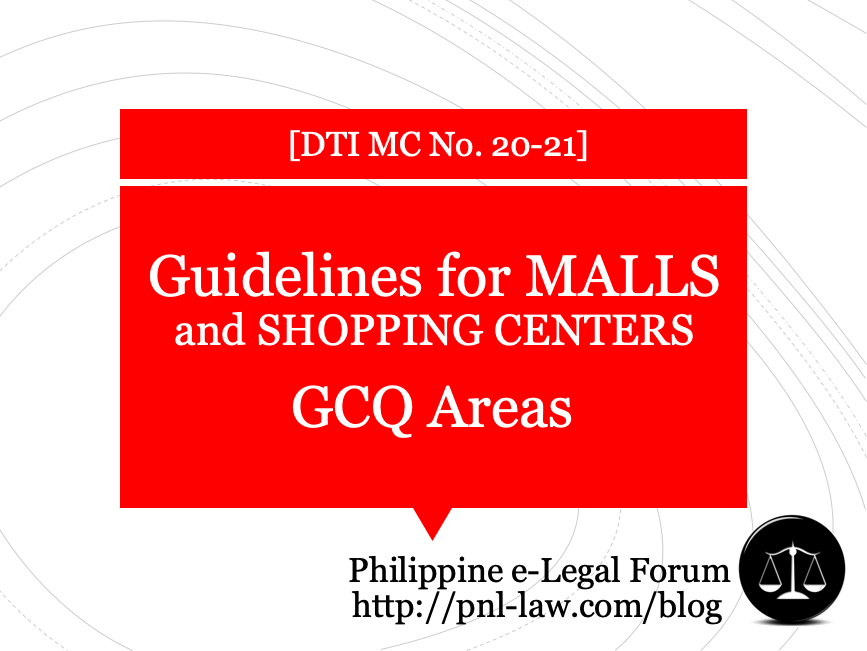Malls and shopping centers are allowed to open in areas under General Community Quarantine (GCQ). The Department of Trade and Industry (DTI) issued Memorandum Circular No. 20-21 dated 4 May 2020, or the “Guidelines on the Operations of Malls and Shopping Centers in Areas Declared Under General Community Quarantine (GCQ)“. The pertinent portions of the guidelines read:

In addition to the minimum health standards prescribed by the DOH and the DTI-DOLE Interim Guidelines on Workplace Prevention and Control of COVID-19, malls and shopping center operators in GCQ areas shall establish and maintain the following measures:
1. strictly monitoring foot traffic and enforcing safe distancing inside the shopping center by:
- a. limiting the number of people inside the mall or shopping center or inside an individual store, at any given time to a density of not more than one (1) person per two (2) square. meters; entry of people shall be limited to the computed carrying capacity of the establishment. Carrying capacity is equal to the total square meters of vacant walkable space divided by two (20); Thus, a 200 square meter vacant space can accommodate 100 people at any time;
- b. the number of open mall entrances may be reduced to better manage the foot traffic inside the mall;
- c. senior citizens, pregnant women, and persons with disabilities (PWD) obtaining essential goods are allowed only one (1) companion;
- d. ensuring social distancing of people (1 meter apart) at all times;
- e. assigning personnel to regulate foot traffic in high-density areas, e.g., comfort rooms, supermarkets, etc.;
- f. ensuring that customers stand on every other step of the escalator to maintain social distancing;
- g. limiting access to elevators to senior citizens, persons with disabilities (PWD), and pregnant women and limiting passengers to only half of the original standard capacity of the unit;
- h. marking or reducing the seats available for customers to use while waiting;
- i. creating one-way flow, where possible, to decongest queues and facilitate movement; and
- j. increasing police visibility, should there be a need to enforce strict physical distancing.
2. assigning a centralized pick up location for stores with delivery/pickup service where delivery service providers can pick up goods;
3. regulating air conditioning inside the mall to 26 degrees centigrade;
4. turning off free Wi-Fi for customers;
5. suspending the conduct of sale events, marketing events, and other promotions which tend to attract large crowds; and
6. implementing other measures that mall and shopping center operators may find necessary (e.g., express lanes).
- Extension of Filing Periods and Suspension of Hearings for March 29 to April 4, 2021: SC Administrative Circular No. 14-2021 (Full Text) - March 28, 2021
- ECQ Bubble for NCR, Bulacan, Cavite, Laguna and Rizal: Resolution No. 106-A (Full Text) - March 27, 2021
- Guidelines on the Administration of COVID-19 Vaccines in the Workplaces (Labor Advisory No. 3) - March 12, 2021
